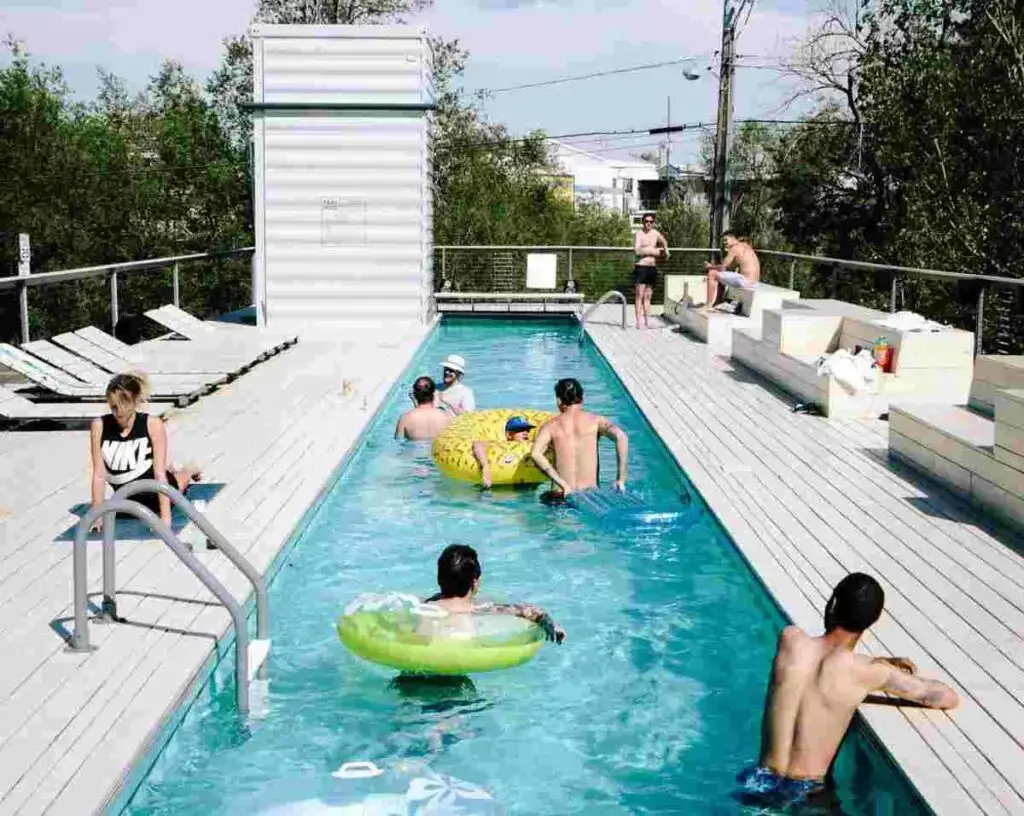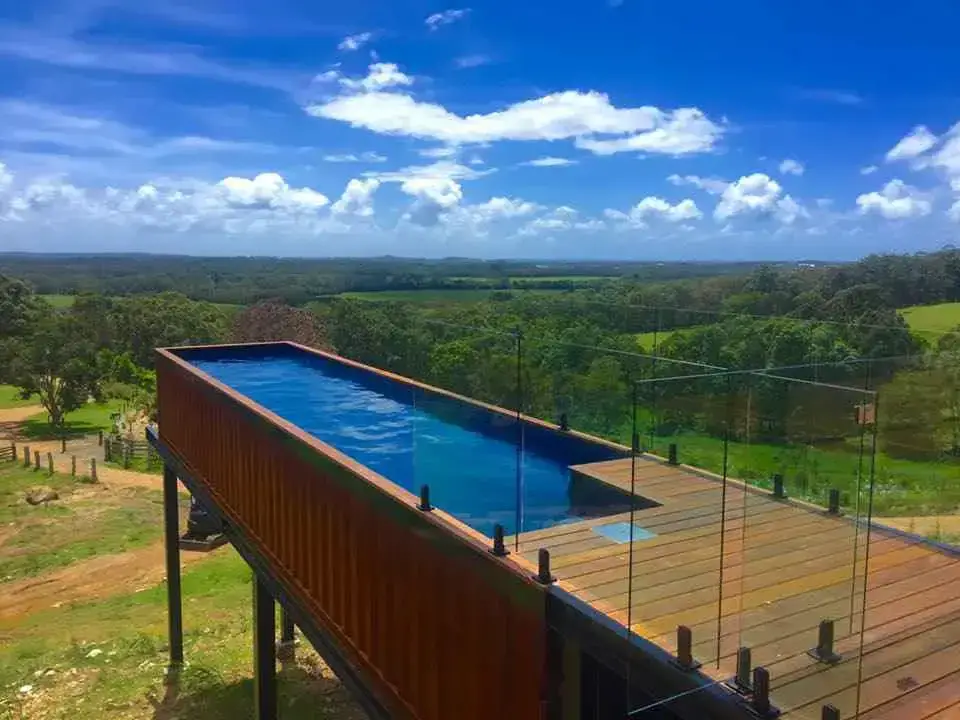Shipping container pools have gained immense popularity in recent years due to their unique and innovative design.
These pools are created by transforming shipping containers into luxurious and functional swimming pools.
In this article, we will provide an overview of shipping container pools, highlighting their benefits and importance of proper installation and maintenance.
Table of Contents
A. Definition and Overview of Shipping Container Pools
Shipping container pools are swimming pools that are constructed using repurposed shipping containers.
These containers are transformed into pools by cutting out one or more sides and adding fittings for filtration and water circulation. They offer a creative and versatile alternative to traditional in-ground or above-ground pools.
Read More: 8 Of The Best Shipping Container Pools In Texas Builders
B. Benefits of Shipping Container Pools
1. Portability and Versatility
One of the major advantages of shipping container pools is their portability. These pools can be easily transported to different locations, making them ideal for homeowners who frequently move or desire a temporary pool solution.
Additionally, shipping container pools can be customized to fit various sizes and configurations, allowing for flexible placement.
Read More: Exclusive Pros, Cons, And Costs Of Shipping Container Homes
2. Cost-effectiveness
Compared to traditional pools, shipping container pools are a more budget-friendly option. The cost of purchasing and converting a shipping container into a pool is significantly lower than the expenses involved in constructing a conventional pool from scratch.
This makes shipping container pools an attractive choice for individuals looking to enjoy the benefits of having a pool without breaking the bank.
Read More: How to Add Plumbing to a Shipping Container Home
3. Sustainable Living
Choosing a shipping container pool is a sustainable choice for pool enthusiasts. By repurposing shipping containers, we reduce the demand for new construction materials, thus contributing to environmental conservation.
Furthermore, these pools can be equipped with eco-friendly filtration systems and energy-efficient accessories, minimizing water and energy consumption.
4. Durability and Longevity
Shipping containers are built to withstand harsh weather conditions and tough handling during transportation. This durability translates into longevity for shipping container pools.
These pools are resistant to corrosion, rust, and decay, ensuring years of hassle-free enjoyment for the pool owners.
In addition, as the containers are made from sturdy materials such as steel, they offer excellent structural integrity.
Read More: Are Container Pools Cheaper? Closer Look At Some Top Builders
C. Importance of Proper Installation and Maintenance
To fully enjoy the benefits of a shipping container pool, proper installation and regular maintenance are crucial.
Professional installation ensures that the pool meets safety standards and operates efficiently. Moreover, proper maintenance, including regular cleaning, chemical balance, and equipment upkeep, ensures the longevity and optimal performance of the pool.
Investing in a shipping container pool provides an exciting and unique swimming experience while offering various benefits in terms of portability, cost-effectiveness, sustainability, and durability.
With proper installation and maintenance, these pools can become a long-lasting and enjoyable addition to any home.
Understanding Shipping Containers
A. Introduction to Shipping Containers
Shipping containers, often referred to as cargo containers, are primarily used for transporting goods via the global shipping industry. They are designed to withstand the rigors of long-distance travel by sea, land, and rail.
B. Characteristics of Shipping Containers
- Material – Steel
Shipping containers are constructed using durable, weather-resistant steel. This material ensures that the containers can withstand harsh weather conditions and resist corrosion.
- Sizes and Dimensions
Shipping containers come in various sizes and dimensions, with the most common sizes being 20 feet and 40 feet in length. These standardized dimensions allow for efficient stacking and transportation.
- Durability and Strength
Shipping containers are designed to be incredibly sturdy and capable of withstanding the weight of other containers stacked on top of them during transport. They are built to last for many years.
C. Safety Considerations of Shipping Container Pools
1. Insulation and Ventilation
When repurposing shipping containers as pools, insulation and ventilation are essential considerations to ensure a comfortable and safe swimming experience.
Proper insulation helps maintain the water temperature, while ventilation ensures adequate airflow.
2. Waterproofing of Cargo Container Pools
To prevent leaks and water damage, shipping containers need to be properly waterproofed before converting them into pools. This involves sealing any cracks or openings and applying a waterproof coating.
3. Shipping Container Pool Installation
Installing a shipping container pool involves modifying the container to create an opening for the pool, reinforcing the structure for added support, and plumbing in the necessary pipes and filtration systems.
4. Costs and Pricing of Shipping Container Pools
The costs of shipping container pools can vary depending on factors such as size, customization, location, and additional features.
It’s important to consider both the upfront costs and potential long-term savings when comparing pricing options.
While container pools are often less expensive than traditional in-ground swimming pools, it’s hard to make a direct comparison because the two types of swimming spaces have many dissimilarities.
All things being equal, an in-ground pool will be closer to ground level than a intermodal container pool. However, several factors, such as your yard’s topography and aesthetic preferences, will affect how high the water line ends up at any given moment.
In-Ground Pool vs Container Pool Cost
The average price of an in-ground pool is between $37,000 and $67,000. In comparison, the cost of a shipping container swimming pool usually comes to somewhere between $20,000 and $50,000. So yes, at least when looking at them, averagely, container pools do appear to be a bit cheaper.
If you’re comparing the cost of a container pool manufactured in an area with high living costs and shipped to your home versus buying an inground pool, be sure to consider how much labor will affect each option.
If you can find local workers to do the hard work at low rates, in-ground pool construction will be much less expensive.
Make sure you get quotes for the same features and not just pool size when comparing prices. Many of the costs are similar, regardless of the type or size of container pool you have.
The smaller pool typically costs 25% less than the larger one. So, don’t choose the smaller pool because you think it’s a better deal. Instead, look at how well it fits in your yard and whether or not having space for only two people is enough.
Finally, for those who want to construct their pools, the DIY cost should be around $10,000 or less for a 40 ft intermodal container pool.
5. Maintenance and Durability of Shipping Container Pools
Shipping container pools require regular maintenance to ensure they remain in good condition. This includes cleaning the pool, monitoring water quality, and performing necessary repairs to maintain its durability over time.
6. Exploring Sustainable Living with Shipping Container Pools
Shipping container pools align with sustainable living principles as they repurpose existing structures, reducing the need for new construction materials.
Additionally, they can be designed to include eco-friendly features such as solar heating systems.
7. Conclusion on Container Pool Safety Considerations
In conclusion, understanding the characteristics and safety considerations of shipping containers is crucial when repurposing them as pools.
By considering insulation, ventilation, waterproofing, installation, costs, maintenance, and sustainability, you can create a unique and durable shipping container pool that provides a refreshing and eco-friendly swimming experience.
Shipping Container Pool Installation
A. Planning and Designing a Shipping Container Pool for Your Backyard
Before beginning the installation process, it is crucial to plan and design your shipping container pool according to your backyard’s specific requirements. Consider factors such as size, shape, depth, and features that you desire.
B. Site Preparation and Clearance Requirements
Prior to installation, it is essential to understand and comply with any permits and zoning regulations set by your local authorities.
Additionally, evaluate the ground and foundation to ensure their suitability for accommodating the weight of the pool.
- Permits and Zoning Regulations: Contact your local municipality to obtain the necessary permits and ensure compliance with any zoning regulations regarding the installation of a swimming pool.
- Ground Evaluation and Foundation: Assess the stability and condition of the ground. Make any necessary adjustments or reinforcement to ensure a solid foundation for your shipping container pool.
C. Steps for Pool Installation
- Delivery and Placement of the Shipping Container: Coordinate the delivery and secure proper placement of the shipping container on the prepared site.
- Structural Modifications and Welding: Engage professionals to undertake any structural modifications required to ensure the pool’s integrity. Welding may be necessary to reinforce certain areas.
- Plumbing and Electrical Installations: Hire a licensed plumber and electrician to handle the installation of the necessary plumbing and electrical systems for your pool’s functionality.
- Sealing and Waterproofing: Apply appropriate sealants and waterproofing materials to ensure the durability and longevity of your shipping container pool.
- Interior Finishing and Pool Equipment Installation: Apply finishes to the interior surfaces of the pool and install necessary equipment such as filters, pumps, and heaters to create a comfortable swimming experience.
D. Hiring Professionals vs. DIY Installation
Deciding whether to hire professionals or opt for a DIY installation depends on your level of expertise, time availability, and comfort with handling the complexity of the installation process.
Hiring professionals ensures a smoother and more efficient installation, while DIY can be a cost-effective option for those with experience and skills.
E. Safety Measures during Installation
When installing a shipping container pool, it is crucial to prioritize safety. Take necessary precautions such as wearing protective gear, following proper lifting techniques, and ensuring a secure work environment. If in doubt, consult professionals for guidance.
Costs and Pricing of Shipping Container Pools
When it comes to creating a unique and stylish outdoor oasis, shipping container pools have become increasingly popular.
Not only do these pools offer a modern and innovative design, but they also come with a wide range of pricing options to fit every budget.
In this section, we will explore the various factors that affect the cost of shipping container pools, compare their costs with traditional pools, provide an average price range, and share some budgeting tips and financing options for those interested in creating their own shipping container pool.
A. Factors Affecting the Cost
1. Size and Dimensions: The size and dimensions of a shipping container pool play a significant role in determining its cost.
Generally, the larger the pool, the higher the price. Additional considerations include depth, shape, and any custom modifications that may be needed.
2. Customization Options: One of the biggest advantages of shipping container pools is the ability to customize them according to personal preferences.
However, keep in mind that the level of customization you choose will directly impact the price. Options such as built-in seating, water features, heating systems, and lighting can significantly increase the cost.
3. Additional Features and Accessories: In addition to customization options, there are various features and accessories available that can enhance the functionality and aesthetics of your shipping container pool.
These may include pool covers, decks, filtration systems, water treatment systems, and more. Each added feature will contribute to the overall cost of the pool.
B. Comparison of Costs with Traditional Pools
When comparing the costs of shipping container pools to traditional pools, it’s essential to consider the unique characteristics and benefits they offer.
While traditional pools often require extensive construction and landscaping, shipping container pools provide a more cost-effective and time-efficient alternative.
The average cost of a traditional in-ground pool can range from tens of thousands to hundreds of thousands of dollars, depending on the size and customization options.
In contrast, shipping container pools can be a more affordable option, with prices typically ranging from $20,000 to $50,000, depending on the factors mentioned earlier.
C. Average Price Range for Shipping Container Pools
We touched on this earlier, but to insist, the average price range for shipping container pools is influenced by a variety of factors, including size, customization, additional features, and market demand.
On average, expect to spend between $20,000 and $50,000 for a shipping container pool. It’s important to note that these figures are estimates, and prices can vary significantly based on individual preferences and specific project requirements.
D. Budgeting Tips and Financing Options
Creating a shipping container pool is an investment, and it’s essential to plan your budget accordingly. Here are some tips to help you stay within your financial means:
- Research and compare prices from different shipping container pool suppliers to find the best deal.
- Prioritize your must-have features and accessories to avoid overspending on unnecessary additions.
- Consider financing options such as personal loans, home equity loans, or credit cards with low-interest rates.
- Explore local grants, incentives, or financing programs that support sustainable living and eco-friendly projects.
By carefully planning and considering your options, you can turn your dream of owning a shipping container pool into a reality without breaking the bank.
Maintenance and Durability of Shipping Container Pools
A. Proper Pool Maintenance for Longevity
Ensuring the longevity of your shipping container pool requires proper maintenance. By following these essential maintenance practices, you can enjoy your pool for years to come:
- Regular Cleaning and Water Treatment: Regularly clean the pool’s interior and exterior to prevent the buildup of debris and algae. Additionally, maintain proper water chemistry by regularly testing and adjusting the water’s pH levels, chlorine, and other chemicals as necessary.
- Maintenance of Pool Equipment: Regularly inspect and maintain pool equipment such as filters, pumps, and heaters. Clean or replace filters as needed and ensure proper functioning of all components.
B. Extended Durability of Shipping Container Pools
To enhance the durability of your shipping container pool, consider implementing these measures:
- Material Protection and Anti-corrosion Measures: Apply a protective coating or paint to the container’s exterior to prevent corrosion. Regularly inspect and touch up any areas where the coating may have worn off. Additionally, consider installing sacrificial anodes to minimize corrosion on metal components.
- Seasonal Maintenance Considerations: Account for seasonal changes by adjusting pool water levels and implementing appropriate maintenance routines. During colder months, drain and winterize the pool to prevent freezing and damage. Properly cover the pool when not in use to protect it from debris and harsh weather conditions.
C. Common Maintenance Issues and Troubleshooting Tips
Despite thorough maintenance, certain issues may arise. Here are some common maintenance issues and troubleshooting tips:
- Green Pool: If your pool turns green, it may indicate an algae problem. Shock the pool with a high dose of chlorine and algaecide, then clean and re-balance the water chemistry.
- Leaking Pool: Look for signs of leaks, such as water loss or wet areas around the pool. Identify the source of the leak and repair it promptly to prevent further damage.
- Pump or Filter Malfunction: If your pump or filter is not functioning properly, check for clogs, damaged parts, or electrical issues. Clean or replace clogged filters and consider consulting a professional for further troubleshooting.
What To Look For In A Company Before Buying A Shipping Container Pool
You’ll need to work with a company with structural and waterproofing expertise and the knowledge needed to size, select and install all ancillary equipment required for proper pool operation.
Because of these factors, it would be advisable to work with a company with extensive experience building container pools as one of its main sources.
There are several companies that offer container swimming pools for sale, either as part of a larger product line or as a specialty offering.
Be aware that some companies selling container pools in western countries are just reselling these shipping containers.
That’s not necessarily bad, but make sure to purchase your container from a company with a good reputation.
Exploring Sustainable Living with Shipping Container Pools
A. Environmental Benefits of Shipping Container Pools
When it comes to sustainable living, shipping container pools offer numerous environmental benefits that make them an attractive option.
1. Repurposing and Recycling of Containers
Shipping container pools contribute to the reuse and repurpose movement, giving new life to old containers that may otherwise end up in landfills.
By repurposing shipping containers into pools, we are reducing waste and promoting a circular economy.
2. Reduced Carbon Footprint
Compared to traditional concrete pools, shipping container pools have a significantly lower carbon footprint.
The manufacturing process for concrete requires large amounts of energy and contributes to carbon dioxide emissions.
In contrast, repurposing shipping containers requires minimal energy and saves on construction materials.
3. Water Conservation Measures
Shipping container pools can be designed with water conservation in mind. By implementing efficient filtration systems and water-saving technologies, such as covers and rainwater collection systems, you can significantly reduce water consumption compared to traditional pools.
B. Eco-friendly Pool Accessories and Technologies
In addition to the environmental benefits of the pools themselves, there are various eco-friendly pool accessories and technologies that can be incorporated into shipping container pool setups.
1. Solar Pool Heating Systems
Solar pool heating systems utilize the power of the sun to heat your pool water, reducing the need for electricity or gas-powered heating. By harnessing renewable energy, you can lower your carbon footprint and decrease energy costs.
2. Energy-efficient Pool Pumps and Filters
Choosing energy-efficient pool pumps and filters can greatly reduce energy consumption. These modern technologies are designed to operate more efficiently, saving both energy and money while still maintaining excellent water quality.
C. Promoting Sustainable Lifestyle Choices with Shipping Container Pools
Embracing shipping container pools aligns with a sustainable lifestyle and encourages responsible choices beyond just the pool itself.
By opting for a shipping container pool, you are supporting the repurposing and recycling of materials, reducing your carbon footprint, conserving water, and embracing eco-friendly pool accessories and technologies.
This decision showcases your commitment to sustainability and inspires others to make responsible choices for a more environmentally friendly future.
Shipping Container Pool Examples
TAXI Apartment Container Pool

In Denver, Colorado, the TAXI Mixed Use Development repurposed an old depot of a taxi company into offices and apartments. One unique amenity is its extra-long container pool that it is available in some of its apartment units.
The builder, Corvus Design Build, combined two 40 ft containers to create an Olympic-length swimming pool surrounded by an expansive deck on all sides. It’s the perfect place for residents to socialize.
South Africa Learn to Swim Container Pool

This seemingly simple pool may not be as flashy or hi-tech as others, but it represents an excellent concept. It’s one of many pools that the primary schools in Ekurhuleni, South Africa use.
These pools give children their first swimming lessons, helping to prevent accidental deaths and injuries. The murals decorating the pool’s sides create a fun atmosphere that can make daunting learning tasks less intimidating.
Read More: 10 Greatest Shipping Container Garage Examples From Across The World
Hillside Container Pool at Australian Home

This stunning pool, built by Shipping Container Pools as part of a custom home in Coolum Beach, Queensland, Australia, is your quintessential example of the viral images you see when people talk about shipping containers being used for construction.
Read More: 15 Best Container Homes You Can Own Under $100K
How to Handle the Delivery of Container Pools
Unless you’re doing an in-place DIY build, your shipping container swimming pool will be fabricated offsite. When it’s ready to install, it must be brought from the fabrication site and installed at home by a professional company.
While there are many ways to offload your container pool, a small crane is the most likely choice. This gives you some food for thought.
First is whether the container crane can drive to the pool site as near as possible. Next is where the detachable crane may place its outriggers, swing boom, etc.
It takes great care to place a new container pool without damaging existing underground pipes, wires, trees, fences, and buildings.
Where Can you Place a Container Pool?
Because they are made of smaller containers, container pools are much more flexible regarding placement options.
Their small size enables the container pools to be placed in very compact areas where larger traditional pools would never fit, such as backyards with small spaces or apartments with balconies.
The agility of a fabricated container pool and its ability to create usable space out of seemingly unusable lots are additional reasons for the popularity of these container pools.
A container pool can be placed almost anywhere, as long as you build a strong foundation to support it. This allows pool builders to overcome the challenges posed by sloping, uneven terrain, or other natural obstacles.
You can also configure a pooling container adjacent to retaining walls, creating a hybrid aboveground and inground swimming area. This adds some nice variety for placement options.
Will a Container Pool Rust?
The weathering steel used in shipping containers immediately gains a thin oxidation layer. This coating is so porous that it doesn’t require further protection against rust.
However, this isn’t a perfect solution. Container rust can still be a problem without proper care and maintenance.
While the steel used in weathering containers is designed to resist corrosion better than untreated steel, it does not completely halt degradation.
Placing a container in an environment with constant exposure to water presents significant challenges for all types of materials.
When you consider that the chemicals used to keep pools sanitary also accelerate corrosion, it becomes clear that this is a serious problem.
High-quality coatings do exist, though. Once applied to a metal surface, they will keep rust from appearing and protect the object for some time.
However, at some point, many years down the road, you may need to apply another coating or polish the existing one-off. But corrosion can be managed if you take care of your pool’s condition well.
Read More: How to Remove Rust From a Shipping Container: Do the Following
Optional Container Pool Features?
The most well-known feature of the pool is its see-through walls, which allow people outside to watch swimmers underwater or vice versa.
It effectively transforms your pool into a human aquarium and is something that is rarely seen in residential pools.
Some manufacturers sell a removable dividing wall that you can use to turn your pool into a hot tub/jacuzzi whenever you want. And just as easily, removing this divider and returning to having full-length swimming space is possible.
Saltwater systems, water heaters, and unusual lighting arrangements are just a few ways pools have changed. Some people even opt to use phone apps instead of diving boards.
Read More: What Are The Different Types Of Solar Energy?
Conclusion
After exploring all aspects of shipping container pools, it is clear that they offer a unique and sustainable solution for those looking to enjoy their own backyard oasis. Let’s recap the key points we have covered throughout this guide:
A. Recap of Key Points
- Shipping container pools repurpose old containers, making them an environmentally friendly choice
- They can be customized to fit any backyard space
- Installation is relatively quick and cost-effective compared to traditional pool construction
- Maintenance is minimal, thanks to the durable materials used
- Shipping container pools offer a modern and unique aesthetic
B. Final Thoughts on Shipping Container Pools
Investing in a shipping container pool not only enhances your outdoor living space but also contributes to sustainable living.
By repurposing old containers, you are reducing waste and embracing a more eco-friendly lifestyle. Not to mention, the modern design and versatility of these pools make them a focal point in any backyard.
C. Call-to-Action for Readers to Explore Shipping Container Pool Options
Ready to transform your backyard with a shipping container pool? Explore our wide range of options and find the perfect pool for your lifestyle. Dive into the world of shipping container pools today and create your own oasis.

